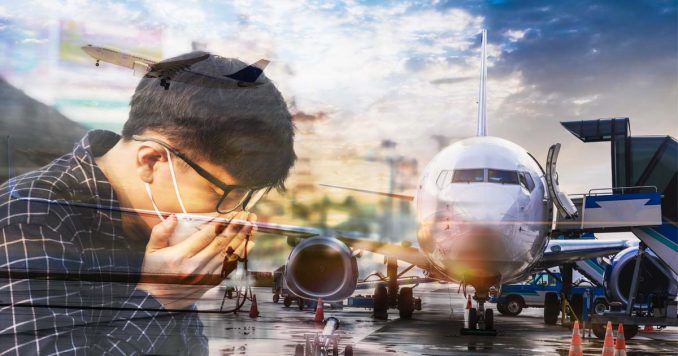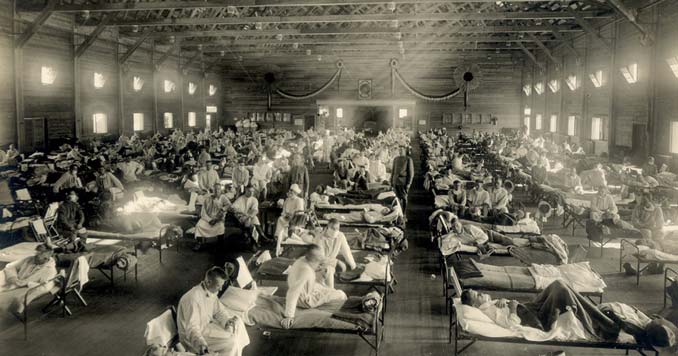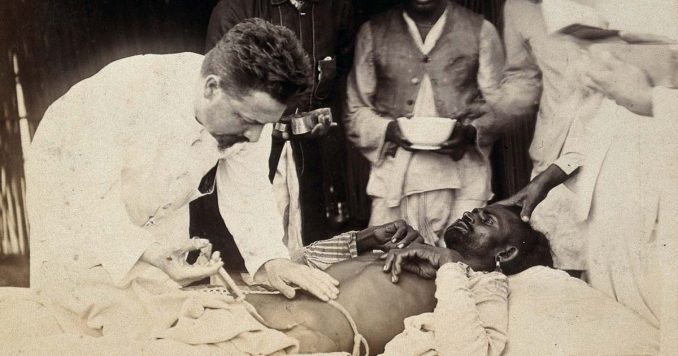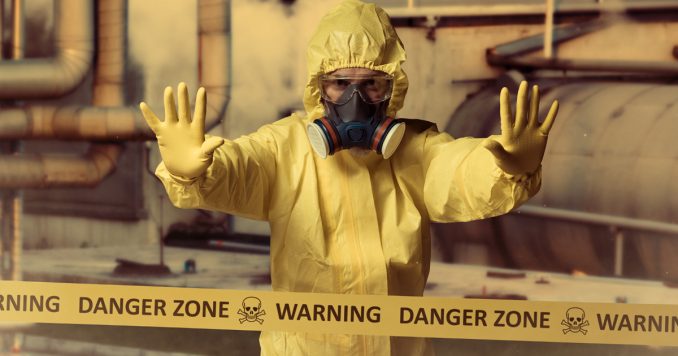
It’s not a matter of if, but when! The fact is at some point a major pandemic is going to sweep across the planet. While it’s hard to say what virus will turn into the next great pandemic, one look at history will show you that pandemic threats and disease outbreaks are among the top threats we face.
Throughout history there have been a number of major pandemics; in fact, almost every recorded civilization has been affected by these outbreaks. From smallpox and tuberculosis to the Bubonic Plague and major flu outbreaks, pandemics are a very real concern, even in our modern age of medicine.
From the current nCov Outbreak that has the world declaring public health emergencies to the Ebloa scare that started in 2013, one thing is clear — governments, business and people are not prepared!
The History of Pandemics – Major Recent Pandemic Outbreaks
Over the last couple hundred years, hundreds of millions of people have died as the result of pandemic outbreaks. Here are a couple of the big ones that have hit during recent times.
1918 Flu Pandemic – The Spanish Flu

The Flu Pandemic of 1918 is perhaps one of the most recent, and deadly contagions to hit North America. In March 1918, a highly deadly form of the flu virus broke out in a US military camp in Kansas. Within six months the virus had spread throughout the world, infecting 40% of the population, and killing an estimated 50 million people.
In the United States, nearly 675,000 people died during the pandemic outbreak. Of those that died, most were healthy adults; in fact, the highest casualty rates came among those in the 20 – 50-year-old age group. To this day researchers are not sure why that age group was affected, as these types of outbreaks usually affect older and younger age groups.
Recently, scientists have begun work to bring back the 1918 flu virus, which was found preserved in the permafrost of Alaska. They hope to study the virus to prevent future outbreaks, but some wonder if they are playing with fire by even attempting to resurrect this deadly contagion.
Third Pandemic

The Third Pandemic, caused by the Bubonic Plague, started in 1855 and was not fully contained until 1959. It’s thought that the pandemic may have been spread through transporting infected people, rats, and cargo harboring fleas through ocean-going trade. The pandemic later took on pneumonic characteristics and began spreading from person to person.
While the secondary strain was mostly confined to Asia, it’s estimated that some 12 million people throughout the world eventually died as a result of the Third Pandemic. It’s thought that the Third Pandemic may have been the root cause of the San Francisco plague of 1900–1904, which was the first recorded Pandemic to hit the United States.
Today, conditions in homeless communities throughout California are so bad that doctors have warned the area could see an outbreak of Bubonic Plague.
Cholera Outbreaks

During the 19th century, Cholera outbreaks were responsible for killing tens of millions of people throughout the world. Worldwide, it still affects 3–5 million people every year and is responsible for somewhere around 100,000–130,000 deaths a year
Smallpox

Smallpox is a highly contagious disease that is estimated to have killed 300–500 million people during the 20th century. Although the disease was successfully eradicated in 1979, a few recent cases have popped up, most notably one in a research laboratory that was responsible for smallpox research.
Since that incident, the World Health Organization has recommended the destruction of all remaining lab samples of the virus, to date that has not been done.
Dangers of a Pandemic Outbreak in Today’s Society
Ask most researchers and they will tell you that it’s not a matter of if, but when. In a story that we covered on global pandemics, Jason Tetro, a microbiologist with the Emerging Pathogens Research Centre and the Centre for Research on Environmental Microbiology told us, “I believe that the world is becoming increasingly more likely to see a significant event. It’s a process that is highly predictable.”
He went on to say, a pandemic outbreak in today’s world would likely travel much quicker and could cause far more deaths than previous pandemics.
Tetro said “When one thinks that almost 100 years ago, when we had the 1918 pandemic, it could take months to circumnavigate the globe. Today, it can be accomplished in a day. Moreover, with more individuals traveling than ever before, the opportunity for a pandemic strain to spread is greater than it has ever been.”
How Real is the Pandemic Threat?
This is a subject that we have covered on multiple occasions, primarily because it’s one of the most likely, and based on past experiences, predictable disasters that our civilization will face. If history teaches us anything, it shows us how dangerous and real this threat is to our future.
Like Jason Petro told us, today’s world is prime for a pandemic. The way we live, travel, and buy our food makes us more susceptible to pandemics than any time in the history of mankind. Remember it’s not if it will happen; it’s when.
Unfortunately, in today’s world, political correctness is also something we need to think about when it comes to pandemic planning. Sadly, because so many world leaders fear being called racist, most will wait far too long to cut off travel from affected countries, causing the virus to spread throughout the world.
In fact, during the height of the 2019-2020 Coronavirus outbreak, some disease experts were so worried about offending people that they couldn’t even decide on what to name the virus, because they feared offending Asians by admitting it was genetically related to the coronavirus responsible for the SARS outbreak of 2003.
And if you think we are being hyperbolas, just check out the World Health Organizations own website. They admit that the only reason they stopped using the virus name SARS-CoV-2 in favor of using the disease name COVID-19 is because they didn’t want to cause “unnecessary fear for some populations.”
This is quite concerning that our WOKE culture has now invaded the scientific medical community to a point where it is affecting public health and preparedness! We need the truth during these types of outbreaks, and unfortunately some people would rather wear blinders!
What diseases are most likely to cause a Pandemic?
Back in 2017, a team of researchers at Johns Hopkins Center for Health Security in Baltimore looked at that question. In the past, pathogens like Ebola and Zika virus were the most likely to alarm the public, but according to the research those pathogens are unlikely to cause a global pandemic disaster.
Instead, the report said that viruses that are spread through the air — including those like the common cold virus — pose the largest threat of becoming a pandemic.
The report suggests that in addition to the pathogen having to be airborne, it would need the following traits to truly be able to be a global pandemic/killer:
- The pathogen would have to be contagious during the “incubation period,” or when people have only mild symptoms.
- It would be a microbe that most people are not immune to, giving it a large population of susceptible hosts.
- It wouldn’t have an existing treatment, vaccine or prevention method.
- It would have a “low but significant” fatality rate — A pathogen with a high fatality rate could kill too many hosts too quickly, and therefore run out of people to spread it further.
The study claimed that a group of viruses known as RNA viruses have the highest likelihood of causing a global pandemic crisis. This includes viruses like the flu (influenza) and SARS, but also things like the common cold.
What would a Worldwide Pandemic Look Like?

Based on past pandemics, we know that millions upon millions of deaths are a real possibility. Just months before the nCov outbreak in China, the Bill and Melinda Gates Foundation and John Hopkins University ran a simulation of what an outbreak of a theoretical Coronavirus Pandemic could look like.
The simulation exercise exposed massive preparedness gap. In the simulation, the immune-resistant virus (nicknamed CAPS) resulted in a death toll of 65 million people within 18 months—surpassing the deadliest pandemic in history, the 1918 Spanish flu.
With the advent of modern technology and travel, that number will likely be much higher than anything we’ve ever seen.
Places in this world that were once remote, and removed from the rest of the world, are now only a plane trip away. These areas in the world, like third-world nations where these diseases still exist, are now traveled to more than ever before. The fact is it’s only a matter of time before a pandemic sweeps across the globe.
How will a Pandemic Affect our Lives?
During the 1918 flu pandemic, over 500 million were infected; it’s estimated that 50 million of them died. Even in areas where mortality rates were low, the population was still severely affected. Hospitals were overwhelmed, schools were shut down, stores closed for weeks, and people had to make do with what they had.
Sadly, today’s technology has left the world unprepared for a pandemic outbreak. Without people to work, protect, and maintain our antiquated infrastructure you will quickly see the system shut down.
From utilities and municipal water supplies to food delivery systems and commerce, our system needs people to maintain this incredibly complex system we’ve grown dependent on. As people start to become ill, our system will quickly become overwhelmed. If we’re not prepared to deal with that, the consequences of an infrastructure shut down might kill more people than the actual illness.
What can you do you do to protect yourself for a Pandemic Outbreak?

Preparing for the possibility of a Pandemic Outbreak is similar to the preparations one would make for any disaster that would leave you without adequate food and water supplies, or access to emergency services for an extended period.
In all likelihood, the Government is not ready, and will not be able to help if things get really bad. On top of the virus outbreak, we are likely to see mass amounts of social unrest, a run on things like food, household supplies, sanitation supplies, and guns and ammo. You will also likely see some form of martial law enacted — though they will likely call it an emergency declaration or something to that effect.
If that happens you could see the government take control of food supplies, restrict travel, restrict civil liberties, and in some areas even restrict the sale of things like liquor, guns, and ammunition.
I’ve been warning people about this for over a decade. In fact, it was the basis for why I wrote my book, The Ultimate Situational Survival Guide: Self-Reliance Strategies for a Dangerous World.
I suggest taking the following steps:
Start Stockpiling Food and Emergency Supplies: The first thing you need to do, is make sure you have your essential needs covered. In the case of a pandemic, the essentials include water, shelter, food, sanitation, medications, and personal security. During a Pandemic, the less contact you have with others, the better your chances are of staying healthy.
Previous pandemics have gone through communities in a matter of six to eight weeks; at a minimum, you should have at least a six to eight weeks’ worth of emergency supplies on hand at all times. Once you have that covered, you can then set a goal to stockpile enough for 3, 6 and then 12 months.
Social Distancing is the Key to Avoiding the Outbreak: The best way to improve your chances of staying healthy during an outbreak is to practice social distancing. This means limiting your contact with others, and staying at least 6 feet away from people if you do have to go out.
Stay Clean & Practice Good Hygiene: Just like with all person to person disease, the key to prevention lies in good hygiene. Hand washing is obvious, and when used for 30 seconds even a simple alcohol-based hand sanitizer, which has between 62 and 75% ethanol, can be enough to kill nearly any pandemic pathogen.
Hospitals & Shelters Should Be Avoided: If you’re sick, then, by all means, you probably need to consult with a medical professional for medical advice. That being said, hospitals will be ground zero in the war and should be avoided if at all possible. Also, if you can, avoid shelters or areas where large groups of people gather, as the disease spreads more quickly in those environments.
When venturing Out, Wear a Mask and Safety Glasses: In my opinion, masks are a last resort and cannot be relied on to stop infection. Respirators are designed to help reduce, not eliminate exposures to disease. With that being said, having some N95 or N99 Medical Masks is something that should be in any good emergency kit. I would also throw in a good pair of safety glasses or lab approved safety googles, as your eyes are another pathway to infection.
Our Pandemic Preparedness recommendations are the same as any other potential disaster or crisis; be prepared, but don’t give into fear! We are a preparedness website; and we make the same recommendations that we have been making since we started this site — it’s always wise to be prepared for both short and long-term disasters and crisis.
Don’t Forget Emergency Communications: The ability to send and receive the latest news is Vital!
Modern society has become dependent on the mainstream media and other internet sources to try to figure out what is going on. But what happens if our infrastructure is affected by a long-term pandemic where people stop showing up to run the vital systems we need to keep the internet working and the power-grid up and running? Or, as the case in China, during the current COVID-19 Outbreak, what if information is heavily censored and your government blocks internet access?
This is where we think HAM Radio starts to serve a vital lifeline to the community. If the Shit hits the Fan, you need to make sure you can find uncensored information worldwide, nationwide, and locally. A good Solar Power Ham Radio Setup can be used to keep you informed indefinitely, even after other sources of communication and news have been taken down or censored. It’s gonna be hard for Facebook, Twitter, Google or the federal government to censor Ham Radio!
We recommend the following Radios:
- For Worldwide Access to Information and the ability to communicate around the world we like the ICOM IC-7300, the ICOM IC-718, or the FT891 Yaesu.
- For Local COMS and News, we recommend the FT-70 Yaesu or the Yaesu FT-60R.
More Preparedness Resources
- Prepper 101: Your Survival Guide to Getting Started
- Emergency Preparedness Checklist: This applies to all disasters and threats.
- Have a stockpile of long-term Food Supplies and Water: 56 Long-Term Survival Foods and Supplies at the Grocery Store




Hi, guys
Just look at this!
Reading this in January 2021 and talk of martial law amidst Covid-19. I’m a little scared yall.